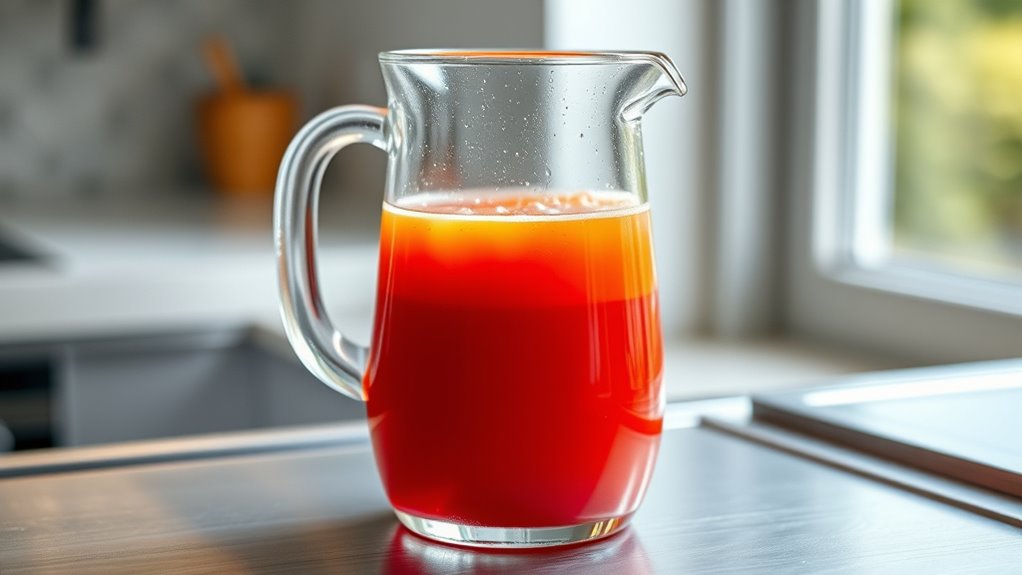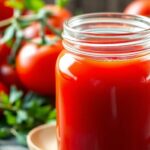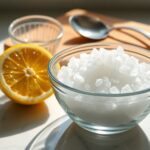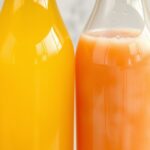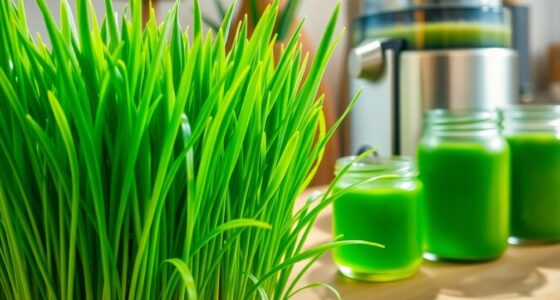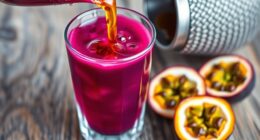To prevent separation and sediment in stored juices, control the pH by adding acids like citric acid to stabilize the mixture. Implement thorough pasteurization to kill spoilage organisms and deactivate enzymes that cause clouding. Additionally, use filtration to remove suspended solids before bottling. Keep your storage environment cool and consistent to preserve clarity. If you want to discover more about effective techniques, there’s much more to explore beyond these basics.
Key Takeaways
- Adjust juice pH with acids like citric acid to inhibit enzyme activity and prevent separation.
- Properly pasteurize to eliminate microbes and inactivate enzymes that cause clouding and sedimentation.
- Use filtration to remove suspended solids before bottling for enhanced clarity and stability.
- Store juices in cool, stable conditions to slow sediment formation and maintain homogeneity.
- Combine pH control, pasteurization, filtration, and proper storage for optimal long-term juice stability.

Have you ever opened a jar of stored juice only to find it separated or filled with sediment? It’s a common issue that can be frustrating, but understanding how to prevent it can save you time and effort. The key lies in managing the juice’s stability through pH adjustment and proper pasteurization techniques. When juices are not properly stabilized, natural sugars, proteins, and other solids tend to settle or separate over time, especially during storage. This separation isn’t necessarily harmful, but it can affect the juice’s appearance, texture, and overall quality. To minimize this, you need to control the pH level, which influences the stability of the juice’s components. Adjusting the pH ensures the juice remains homogeneous by inhibiting enzyme activity and preventing microbial growth that can cause clouding or sediment formation. Typically, adding acidic agents like citric acid helps achieve the ideal pH, making the juice more resistant to separation.
Pasteurization is equally important in preventing sediment and separation. This process involves heating the juice to a specific temperature for a set period, which kills off spoilage microorganisms and enzymes that can cause destabilization. Different pasteurization techniques, such as flash pasteurization or low-temperature long-time (LTLT) methods, can be employed depending on the juice type. Proper pasteurization not only extends shelf life but also preserves the juice’s clarity and consistency by inactivating enzymes that promote clouding or sedimentation. It’s essential to follow precise temperature and time guidelines because over-pasteurizing can lead to quality loss, while under-pasteurizing might not eliminate all destabilizing enzymes.
In addition to pH adjustment and pasteurization, other measures like filtration and proper storage conditions contribute to preventing sediment. Filtration removes suspended solids before bottling, reducing the chance of sediment forming later. Ensuring the storage environment is cool and stable also helps maintain the juice’s clarity. When these steps are combined—adjusting the pH, applying appropriate pasteurization techniques, and maintaining proper storage—you considerably reduce the likelihood of separation and sediment in your stored juices. It’s a proactive approach that keeps your juice looking appealing and tasting fresh longer. Remember, understanding the science behind these processes empowers you to produce a more stable, high-quality product that resists separation, sedimentation, and spoilage over time.
Frequently Asked Questions
How Long Can Juice Be Stored Before Separation Occurs?
You can typically store juice for up to 7-10 days before separation occurs, depending on the type and storage conditions. To maximize storage duration and preserve quality, keep it refrigerated at or below 40°F and seal the container tightly. As time passes, natural separation might happen, but shaking the juice redistributes the pulp. Regularly check for off-odors or changes in appearance to guarantee freshness and safety.
Does Refrigeration Impact Sediment Formation?
Refrigeration effects can help slow down sediment formation in stored juices, but it doesn’t completely prevent it. Cooler temperatures inhibit enzyme activity and bacterial growth that contribute to sediment, so keeping juice refrigerated is beneficial. However, some sediment may still develop over time due to natural fruit particles settling. To maximize sediment prevention, store your juice in airtight containers and consume it within the recommended timeframe.
Are There Natural Additives to Prevent Separation?
You can use natural stabilizers like pectin, agar-agar, or guar gum as additive alternatives to prevent separation in stored juices. These natural additives help maintain a smooth, uniform consistency by binding particles together. Incorporating them into your juice recipes is simple, and they’re safe and effective. By choosing natural stabilizers, you avoid artificial additives while ensuring your juice stays well-mixed and appealing over time.
Can Pasteurization Influence Sediment Development?
Pasteurization effects are like a gentle shield that can influence sediment development in your stored juices. It helps break down enzymes and bacteria that cause separation, making sediment less likely to form. By properly pasteurizing, you can improve sediment prevention, keeping your juice clearer and more appealing. So, yes, pasteurization can markedly reduce sediment buildup, ensuring your juice stays fresh and smooth longer.
Which Types of Juice Are Most Prone to Separation?
You’ll find that juices with high fruit pulp, like orange or apple juice, are most prone to separation. Pectin stability plays a key role here; when pectin breaks down or isn’t properly stabilized, pulp tends to settle or separate. To diminish this, you can use stabilizers or ensure proper processing. Regular shaking or stirring can also help keep pulp evenly dispersed, maintaining a uniform texture and appearance.
Conclusion
By following these simple tips, you can keep your stored juices clear and fresh, just like a well-shaken cocktail. Imagine your juice as a team working together smoothly—when you prevent separation and sediment, you’re ensuring every sip is just as vibrant as the first. I once left juice sitting overnight, only to find a cloudy mess the next day. With a little care, you can avoid that muddy situation and enjoy crisp, delicious juice anytime.
Cindy thoroughly researches juicing trends, techniques, and recipes to provide readers with practical advice and inspiration. Her writing style is accessible, engaging, and designed to make complex concepts easy to understand. Cindy’s dedication to promoting the advantages of juicing shines through her work, empowering readers to make positive changes in their lives through the simple act of juicing.

